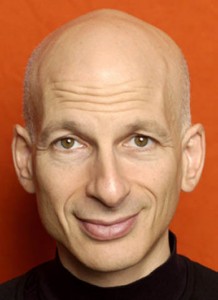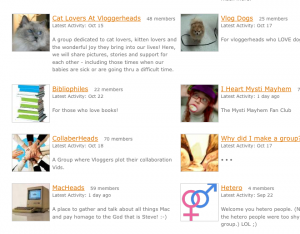 I’ve always had a brain crush on Seth Godin, and used to preach his gospel when I worked at an interactive agency pre-bubble burst. But I had lost touch with the author since his Purple Cow book, and was glad to get a dose of his new “tribal marketing” insights last week in NYC.
I’ve always had a brain crush on Seth Godin, and used to preach his gospel when I worked at an interactive agency pre-bubble burst. But I had lost touch with the author since his Purple Cow book, and was glad to get a dose of his new “tribal marketing” insights last week in NYC.
Here’s a quick summary of Tribes:
- A tribe is any group of people who are connected to one another, a leader, and an idea.
- For millions of years, humans have been seeking out tribes, be they religious, ethnic, economic, political, or even musical (think of the Deadheads). It’s our nature.
- Now the Internet has eliminated the barriers of geography, cost, and time. All those blogs and social networking sites are helping existing tribes get bigger.
As I continue to read about budget challenges with online-video advertising, I’m struck with the stark contrast between:
- ads that surround or interrupt a video (and usually annoy they aren’t ignored).
- the promotional videos I do (and urge other amateurs to make).
 To use an exaggerated example, when Oprah gives away 276 Pontiacs we remember it. When she pimps an author, he becomes a best seller. But name one of the ads that rolled when you were watching Oprah (assuming you didn’t DVR her and zip past ads all together).
To use an exaggerated example, when Oprah gives away 276 Pontiacs we remember it. When she pimps an author, he becomes a best seller. But name one of the ads that rolled when you were watching Oprah (assuming you didn’t DVR her and zip past ads all together).
If I had time, I would have loved to explain YouTube’s tribe to Seth, and how I saw online video in a new light as I listened to him.
- In effect, there are lots of different “tribes” in online video. Most top creators are, in effect, tribal leaders by Seth’s definition.
- My favorite example are the Vlog Brothers. There’s a great pride among the viewers who strongly identify with the term “Nerd Fighters.” They rally, they meet locally, and it gives them a sense of belonging… to rid the world of suck and infuse awesome.
 A long time YouTube advocate, Renetto, led an exodus to Vloggerheads and many followed. In fact the site is now populated with people who aren’t Renetto fans, and sub tribes have formed (dozens of groups).
A long time YouTube advocate, Renetto, led an exodus to Vloggerheads and many followed. In fact the site is now populated with people who aren’t Renetto fans, and sub tribes have formed (dozens of groups).- Gay entertainment reporter Michael Buckley has developed such a regular following with his What the Buck show that even his vlog channel (Peron75) has 65,000 subscribers. His live shows on blog.tv draw hundreds.
I don’t think of myself as a tribe leader, and I try to entertain — not create a sense of intimacy and belonging among viewers. But there have been times where the community rallied on my behalf (like the time I asked for help to get into YouTube’s partners program with this NAPPY video). That video remains one of the most responded to video of all time.
- What does this mean to creators? Considering your family of viewers as a “tribe” will probably foster a greater sense of unity and advocacy. This could result in a faster-growing audience, but also carries challenges and responsibilities. It’s like a second family, and some have time and desire for that, while others don’t.
- What does this mean to advertisers? Despite what you’d hope, most people don’t care about your product or service enough to form a tribe around it (with maybe Mac and cars as exceptions). So your best bet is to join a tribe that exists. But that’s not about advertising in prerolls or even paying the creator to make a paid video. That’s going to involve something far more interesting, that has the tribe see the brand as a welcome member not a self-serving interuption.
